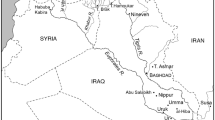Abstract
In what amounts to the blink of an eye in the history of humanity, we have become city dwellers. At the start of human existence, everyone moved; all human groups were hunters and foragers who moved seasonally, following the annual cycles of plants and animals. This pattern prevailed for millions of years. In West Asia, groups began staying in one place for some or all of the year only about 15,000 years ago. By 5000 years ago, cities had appeared. Today, the majority of humans on earth live in urban settlements. It was the most dramatic and rapid transition in human history. Where did it start, and how did it happen?
Access this chapter
Tax calculation will be finalised at checkout
Purchases are for personal use only
Similar content being viewed by others
References
Adams, R.M. 1966. The evolution of urban society. Chicago/New York: Aldine.
Adams, R.M. 1981. Heartland of cities. Chicago: University of Chicago Press.
Al Quntar, S., L. Khalidi, and J.A. Ur. 2011. Proto-urbanism in the late 5th millennium BC: Survey and excavations at Khirbat al-Fakhar/Hamoukar, Northeast Syria. Paléorient 37: 151–175.
Algaze, G. 2008. Ancient Mesopotamia at the dawn of civilization. Chicago/London: University of Chicago.
Algaze, G. 2013. The end of prehistory and the Uruk period. In The Sumerian world, ed. H. Crawford, 68–94. Oxford/New York: Routledge.
Aurenche, O. 1981. La maison orientale, l’architecture du Proche-Orient ancien des origines au milieu du quatième millénaire. Paris: Paul Geuthner.
Bintliff, J. 1999. Settlement and territory. In Companion encyclopedia of archaeology, vol. 1, ed. G. Barker, 505–544. London: Routledge.
Childe, V.G. 1950. The urban revolution. Town Planning Review 21: 3–17.
Cowgill, G.L. 2004. Origins and development of urbanism: Archaeological perspectives. Annual Review of Anthropology 33: 525–549.
Crüsemann, N., M. van Ess, M. Hilgert, and B. Salje (eds.). 2013. Uruk: 5000 Jahre Megacity. Peterberg: Reiss-Engelhorn-Museen, Deutsches Archäologisches Institut.
Emberling, G. 2002. Political control in an early state: The eye temple and the Uruk expansion in northern Mesopotamia. In Of pots and plans: Papers on the archaeology and history of Mesopotamia and Syria presented to David Oates in honour of his 75th birthday, ed. L. al-Gailani Werr, J. Curtis, H. Martin, A. McMahon, and J. Reade, 82–90. London: Nabu Publications.
Emberling, G. 2003. Urban social transformations and the problem of the ‘First City’: New research from Mesopotamia. In The social construction of ancient cities, ed. M.L. Smith, 254–268. Washington, DC/London: Smithsonian Institution.
Gelb, I.J. 1979. Household and family in early Mesopotamia. In State and temple economy in the ancient near east, ed. E. Lipinski, 1–97. Leuven: Departement Oriëntalistiek, Katholieke Universiteit Leuven.
Kouchoukos, N. 2001. Satellite images and near eastern landscapes. Near Eastern Archaeology 64: 80–91.
Liverani, M. 2006. Uruk: The first city. London/Oakville: Equinox.
McMahon, A., A. Sołtysiak, and J. Weber. 2011. Late chalcolithic mass graves at Tell Brak, Syria, and violent conflict during the growth of early city-states. Journal of Field Archaeology 36: 201–220.
Menze, B.H., and J.A. Ur. 2012. Mapping patterns of long-term settlement in northern Mesopotamia at a large scale. Proceedings of the National Academy of Sciences 109: E778–E787.
Nissen, H.J. 1988. The early history of the ancient near east, 9000–2000 BC. Chicago: University of Chicago.
Oates, J., A. McMahon, P. Karsgaard, S. al-Quntar, and J. Ur. 2007. Early Mesopotamian urbanism: A new view from the north. Antiquity 81: 585–600.
Pollock, S. 1999. Ancient Mesopotamia: The Eden the Never Was. Cambridge: Cambridge University Press.
Roaf, M. 1989. Social organization and social activities at Tell Madhhur. In Upon this foundation: The ‘Ubaid’ reconsidered, ed. E.F. Henrickson and I. Thuesen, 91–146. Copenhagen: Carsten Niebuhr Institute of Ancient Near Eastern Studies.
Schloen, J.D. 2001. The house of the father as fact and symbol: Patrimonialism in Ugarit and the ancient near east, Studies in the archaeology and history of the Levant 2. Winona Lake: Eisenbrauns.
Ur, J.A. 2010. Urbanism and cultural landscapes in northeastern Syria: The Tell Hamoukar survey, 1999–2001, Oriental Institute Publications 137. Chicago: University of Chicago Oriental Institute.
Ur, J.A. 2012. Southern Mesopotamia. In A companion to the archaeology of the ancient near east, ed. D.T. Potts, 533–555. Malden/Oxford: Blackwell.
Ur, J.A. 2014a. Households and the emergence of cities in ancient Mesopotamia. Cambridge Archaeological Journal 24: 249–268.
Ur, J.A. 2014b. Urban form at Tell Brak across three millennia. In: Preludes to urbanism: The late chalcolithic of Mesopotamia, eds. A. McMahon, and H. Crawford. Cambridge: McDonald Institute for Archaeological Research.
Ur, J.A., P. Karsgaard, and J. Oates. 2007. Urban development in the ancient near east. Science 317: 1188.
Ur, J.A., P. Karsgaard, and J. Oates. 2011. The spatial dimensions of early Mesopotamian urbanism: The Tell Brak suburban survey, 2003–2006. Iraq 73: 1–19.
Weber, M. 1978. Economy and society, vol. 2. Berkeley: University of California.
Acknowledgements
I am indebted to the Directorate General of Antiquities and Museums in Damascus for permission to carry out research and Brak and Khirbat al-Fakhar/Hamoukar. The Tell Brak Suburban Survey was co-directed by Philip Karsgaard, with survey assistants Fahid Juma’a and Shilan Ramadan, and benefited from the advice and support of Joan and David Oates, Geoff Emberling, Henry Wright, Eric Rupley and Carlo Colantoni. Funding for the Suburban Survey was provided by the British Academy, the McDonald Institute for Archaeological Research (University of Cambridge), the University of Michigan and Harvard University. CORONA imagery is reproduced courtesy of the United States Geological Survey.
Further Reading
There are few works on urban origins intended for the general reader. Recent reviews of the transition to urbanism in ancient West Asia include Algaze (2008, 2013), Pollock (1999), and Ur (2012).
Author information
Authors and Affiliations
Corresponding author
Editor information
Editors and Affiliations
Rights and permissions
Copyright information
© 2017 Springer Science+Business Media Singapore
About this chapter
Cite this chapter
Ur, J. (2017). The Birth of Cities in Ancient West Asia. In: Tsuneki, A., Yamada, S., Hisada, Ki. (eds) Ancient West Asian Civilization. Springer, Singapore. https://doi.org/10.1007/978-981-10-0554-1_9
Download citation
DOI: https://doi.org/10.1007/978-981-10-0554-1_9
Published:
Publisher Name: Springer, Singapore
Print ISBN: 978-981-10-0553-4
Online ISBN: 978-981-10-0554-1
eBook Packages: Social SciencesSocial Sciences (R0)




